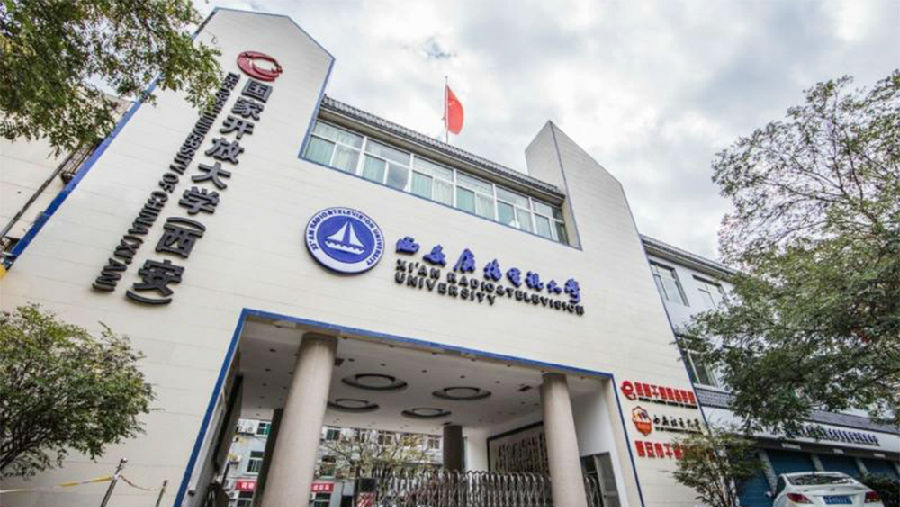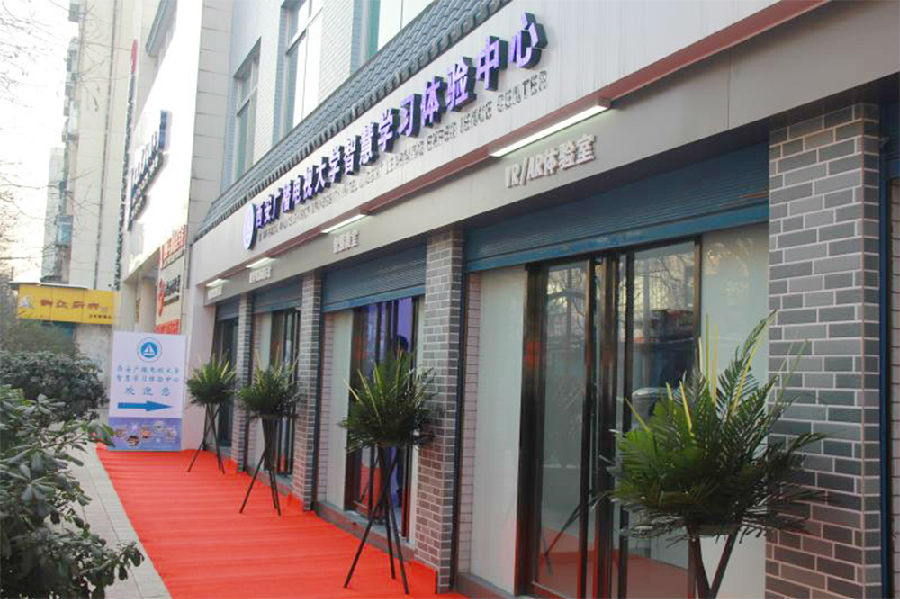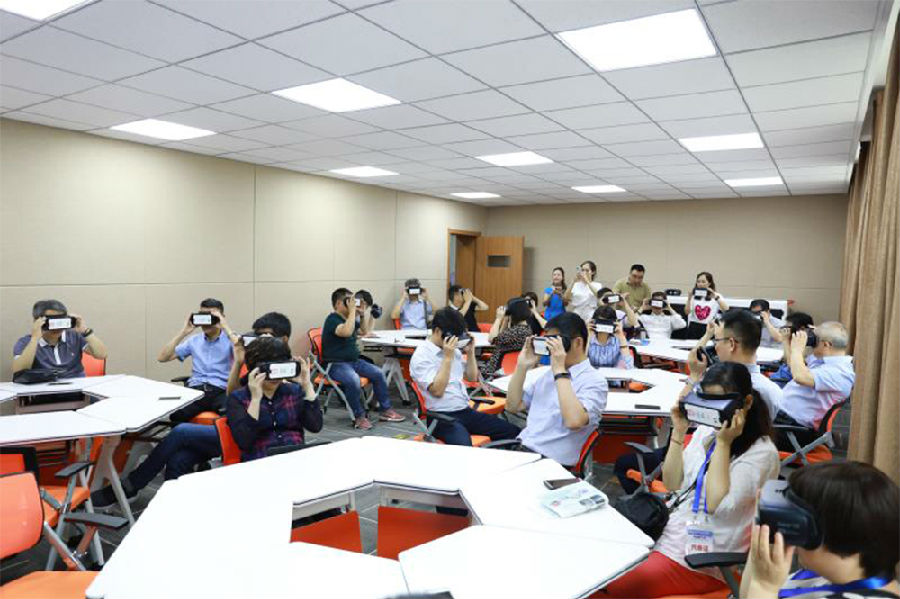 The Internet era offers advanced social and technological conditions for the practice of modern and open education. "Smart education" and "smart learning", which are based on information technology and conform to the cultural ideas of modern education, reflect a student-oriented educational concept.
The Internet era offers advanced social and technological conditions for the practice of modern and open education. "Smart education" and "smart learning", which are based on information technology and conform to the cultural ideas of modern education, reflect a student-oriented educational concept.
In recent years, in order to adapt to the need for open education in Xi’an, Xi'an Radio and Television University (Xi'an RTVU) created a special education brand and comprehensively promoted education informatisation, in the light of the development concept of "meeting individualised learning experiences, creating an open learning environment, providing diverse learning resources, and realising the development of smart talent training,” which has achieved preliminary results.

Ⅰ. Multiple measures taken to build a unique smart learning system at Xi'an RTVU
1. Deepen the reform of the people-centric learner development model
The concept of smart learning and aiding teaching with science and technology has been established. Xi'an RTVU is committed to an intensive development model and is focused on the goal of talent training and the transformation of the supply side of education, in order to meet the needs of students and society. It has continued to optimise its teaching design around training objectives and quality, and has maintained an orientation towards complementary development with the ordinary universities and colleges, with the aim of cultivating high quality workers and applicable professional talents. It has created a concept of smart learning that relies on information technology that it has actively practiced, combining virtual learning methods with in-person methods, strengthening experiential teaching, and providing students with a humanistic environment that allows them to learn at anytime and anywhere. It has also focused on data collection and analysis in terms of students’ smart learning, which is fed back to teaching in a timely manner.
The curriculum system has been reformed and teaching resources have been enriched. Attention has been paid to top level teaching design. In terms of teaching model, Xi'an RTVU applied smart teaching methods to improve teaching effectiveness, implemented a smart learning plan, and accelerated the reform of the teaching model in line with the target of learner development. A teaching support service system integrating online and offline methods has been established. A variety of curriculum resources, including a series of fine quality micro courses and lectures given by famous lecturers, have been constructed. A simulated practical teaching course based on information technology has been developed and new technologies, such as VR and AR, have been introduced to enrich the teaching resources for experimental training. The practical teaching environment has been improved the practical teaching design has been strengthened in order to improve the practical application ability of the students. Measures have been taken to actively promote a pilot program for registering for a single course, establish an open curriculum system, and establish a number of excellent course groups, such as civil construction, management, finance, and accounting and education. Restrictions on majors have been broken and a flexible and convenient "course supermarket" has been constructed in order to continue to meet the individualised needs of learners.
2. Improve the teachers' smart teaching level through both internal and external training
Management innovation has been enacted in order to accelerate the professional growth of teachers. The system and mechanism of teaching management have been innovated and a scientific evaluation system, based on quality assessment and embodying a concept of decent pay for excellent performance apart from inherent qualification and title restrictions, has been established. A reasonable "entry/exit" mechanism has also been implemented. The overall quality of the teaching staff has improved significantly and the spirit of the teachers has taken on a new look. A team of teachers who are willing to contribute and who have good personal quality, business capacity, and work ethic has been formed.
A consensus has been reached in promoting the changes to the teachers' roles. The role of teachers as the main force has been highlighted and structures have been optimised in order to strengthen teachers’ ability to combine research and practice. Teachers' understanding of the talent training goals and the meaning of smart education after the transformation has improved, which reflected the role of new teachers and promoted the overall implementation of teaching. Teachers have gradually changed their roles. Guided by the idea of smart education, they have started to pay attention to the learning background, professional characteristics, and ages of different learning groups, and on this basis, provide individualised teaching for students according to students' learning habits and characteristics.
Special training programs have been carried out in order to improve the information literacy of teachers. In recent years, the university has invited experts such as professor Zheng Guangzhi from Korea National Open University (KNOU) and associate professor Guo Wenji from Peking University to deliver special lectures and conduct study exchanges. They have trained teachers to use modern information technology to reform education and teaching methods, and promoted the organic integration of curriculum teaching and information resources, in order to meet the diverse and personalised learning needs of students. The teachers’ capacity to integrate environment, technology, and teaching in smart learning has been enhanced. Teachers' professional academic and teaching abilities were enhanced through activities such as training programs by famous teachers and following other teachers’ teaching activities, which were aimed at providing opportunities for teachers to offer mutual assistance and to learn from each other, and by means of using the classroom as the platform, focusing on teaching and promoting teaching via evaluation.
3. Use science and technology to upgrade the hardware environment for smart learning
The "two platforms and one terminal” model makes learning more convenient. Thanks to the learning network of the Open University of China (OUC) and Xi'an RTVU’s selective course cloud platform, as well as the mobile auxiliary learning carrier, the "Ren Wo Xue" app, data exchanges between the teaching and educational administration systems were realised, the efficiency of learning support services were improved, and students' self-study and self-management abilities were promoted. From spring 2017 to early 2018, the number of students registered on the cloud platform for selected courses totalled more than 12,000 and more than 10,000 students have signed up for the “Ren Wo Xing” app.
The construction of the Internet + Smart learning environment has improved teaching accuracy. One classroom with recording and broadcasting devices, three cloud classrooms, two 3D virtual studios, one television studio, 30 multimedia classrooms, five smart classrooms, one VR smart classroom, and one room for collaborative lesson preparation have been constructed at the university. A smart educational environment enables learners to fully perceive the learning situation and complete the learning process in a state of full interaction with the teachers. By analysing the characteristics of the learners using big data, such as the number of people attending a class, the number of questions answered by students, the status of the students, and the learning period, among others, we can better understand the needs of the students, give full play to their initiative, provide comprehensive support services with a focus on learning, and make the teaching model more accurate, sensible, and efficient. Through "Internet Learning + Mobile Learning + Blended Featured Learning + Customised Course Learning", Xi'an RTVU has created a unique smart learning environment.
A smart learning experience centre for all has been constructed in order to promote the concept of lifelong learning. The university has built a free smart learning experience centre for all, opened in January 2018. The centre has five areas: a comprehensive exhibition room for university introduction, a teaching resource display room, a smart classroom, a VR/AR experience room, and a reading communication room. As of 6th June 2018, the centre has received more than 1,900 visitors, who have left comments such as: "It’s an eye opener. Science and technology was fully explained and I felt it was very interactive!" As a result, the concept of smart and lifelong learning has been effectively promoted.
4. Multifaceted guarantees ensure the advance of smart learning
Big data has been applied to support targeted services. The application of educational technology has been deepened with a focus on personalised learning, big data targeted services, and multi-terminal autonomous learning. Big data technology has been leveraged to analyse learning behaviours and provide a scientific basis for the prediction and intervention of learning activities. A big data analysis model has been established in order to develop process evaluation and support learning.
It is necessary to co-ordinate the live broadcasting of courses in order to realise the sharing of teaching. The headquarters are responsible for coordinating and organisation, bringing together outstanding teachers, selecting courses, and planning the overall teaching. Thanks to the Internet, video courses can be played with a click and course resources can be shared among multiple centres, which has enabled the synchronous receipt of teaching in different places. A variety of mobile terminals can be used to watch the videos and the resources can be recorded and then pushed to the online "live classroom".

Ⅱ. Initial results have been achieved and the university will continue to push forward smart education
1. Students' are constantly motivated
Smart education diversifies learning content, enriches teaching formats, expands teaching interaction, and makes classroom learning more efficient. For example, when a teacher teaches in a coordinated live broadcast class at the headquarters, students can attend and interact with the teacher in a smart classroom at each branch school. The construction of VR resources for courses such as Accident Management and Emergency Treatment, Property Equipment and Facility Management, Kindergarten Class Management Practices, and many others has been completed and the courses have been put into use. Convenient, flexible learning and rich, varied learning resources have given students more enthusiasm for learning.
2. The smart teaching team matures
The ability of the teachers to use the classroom as a platform and focus on teaching has significantly improved. Smart teaching has narrowed the gap between the teachers and the students, with zero constraints on self-exploration, guiding practices, and authentic evaluation. The teaching team of the department of science and engineering has created its own courses for the major in safety technology and management. Enrolment for the major was launched in spring 2017 and it now has more than 700 students on campus.
3. The information level of teaching management has improved
With the help of big data, the management team has significantly improved its student-centric support service abilities. In spring 2018, Xi'an RTVU launched its first coordinated live broadcast in the smart classroom. A total of six integrated courses, including two finance courses, two grammar courses, and two science and engineering courses, were selected to use the smart classroom, with the total of 6,270 students.
4. The integration of education and information technology has deepened
The university has set up a professional course teaching team with teachers and professional technical personnel as the main body, and has endeavoured to constantly strengthen cooperation and innovation, improve the professional level and practical skills of its teachers, and carry out joint teaching design. It has produced seven OUC Quality courses and 36 online courses, of which ten have won first prizes at the national multimedia courseware contest. 243 micro course series have been created, among which 4,708 classes have been taught through the system and 631 lessons have been taken through the overall planning means, which has brought about the further integration of education and information technology.
5. Smart education has helped the construction of a learning society
In July 2013, Xi'an RTVU became one of the first Learning Achievement Certification Centres of the OUC (Xi'an Sub-Centre). The university has also undertaken the task of creating a "Credit Bank for the Lifelong Education of Citizens in Xi’an." The information platform of Xi’an RTVU’s Credit Bank has already launched, realising the accumulation, storage, and transformation of the credits obtained in the RTVU’s degree education, community education, and other training courses. This has greatly promoted the integration of degree education and various training programs, facilitating the construction of a learning society.
Under the guidance of the spirit of the national congress of the 19th CPC, Xi'an RTVU will focus on the construction of smart education, the integration of advanced technology into education, and the provision of new learning models for different learners, enabling the true integration of learning into our everyday lives, providing more open and better quality lifelong learning services, adapting to the needs of the country in the new era, and playing an important role in the construction of the learning society and the training of talented professionals. In this way, it will establish itself as a first-class smart Open University which is based in Xi’an but covers a wide area and is oriented to everyone in Xi’an.

By He Jing, Zhang Shu, Li Xinran, OUC
Photographer, Yao Hui